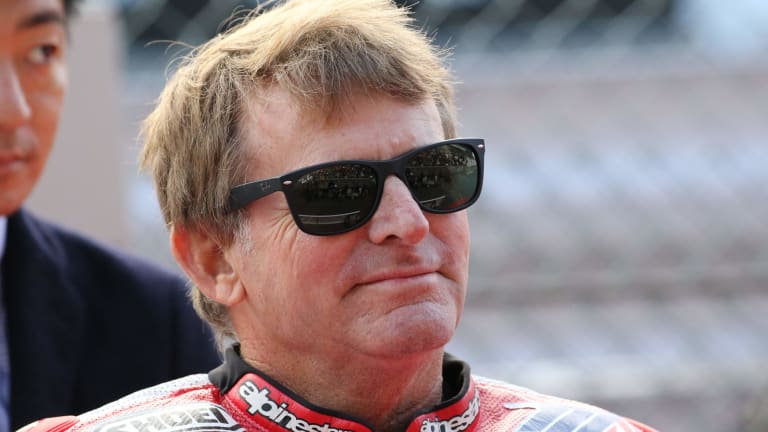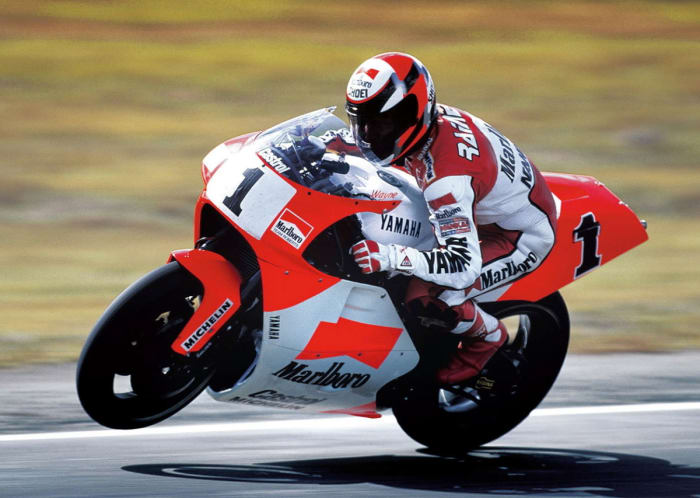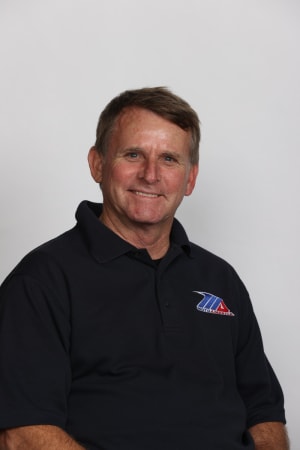
Wayne Rainey Confident MotoAmerica Can Propel American Riders Back to the Top

Wayne Rainey realizes how dominant he and his fellow Americans were in the premier class of Grand Prix motorcycle racing from the mid-1970s through the mid-2010s.
“America really got spoiled, we thought this cash cow would never end,” Rainey said. “We dominated, and a lot of people still talk about it to this day. Sometimes when you have it so good, it makes other people work harder.”
Those other people did work harder.
From 1976 to 2015, the premier motorcycle championship, now known as MotoGP, had at least one full-time American rider in the top-level championship of MotoGP. These riders weren’t just field-fillers: They were race winners and World Champions.
American riders like Kenny Roberts, Freddie Spencer, Eddie Lawson, Rainey, Kevin Schwantz, Kenny Roberts Jr. and Nicky Hayden all won at least one World Championship in the premier class during that span.
But now there isn’t a single American rider in MotoGP. There hasn’t been one since Hayden’s last full-season ride in the premier class in 2015. Quite a downfall from the glory years in the 1980s and 1990s.
Why are there no American riders in the premier class? To answer that question, there may not be a more qualified person than Rainey, who won World Championships as a 500cc rider in 1990, 1991 and 1992 and now serves as president of the top American domestic series, MotoAmerica.

Wayne Rainey won three consecutive 500cc championships from 1990 through 1992. Photo courtesy: MotoAmerica
“I grew up racing flat track out in Southern California as a young kid, Ascot Park, to be exact,” Rainey said. “I excelled through that and traveled the U.S. when I was 16, 17, 18 years old, living in my van.”
California native Rainey first got the opportunity to go road racing in Loudon, New Hampshire. He was dirt racing for Kawasaki when the manufacturer asked him to race in Loudon.
“It was raining in the race,” Rainey said. "It was the first time I had raced in the rain, but I felt pretty comfortable with the bike sliding around with my flat track background. I won the race by quite a bit, and the next day Kawasaki signed me to a factory contract to race Superbikes.”
Once Rainey started racing Superbikes, it wasn’t long until the accolades started piling up. But first, he got help from another American motorcycle legend.
“Kawasaki stops, and it forces me to go on to the next thing, which was racing 250s,” Rainey said. “Kenny Roberts had just retired racing GP, and he was a good friend and he was looking for the next opportunity for himself. With my situation needing a ride and with his retiring from racing, he started a team. Then we raced in the World Championship in 1984. That was very difficult. I had never been out of America.”
Rainey left Roberts’ team to race Superbikes but reunited with Roberts to race for him in the premier 500cc class in 1988.

Wayne Rainey is growing MotoAmerica and hopes to see more American-born riders compete for world championships on the global scene. Photo courtesy: MotoAmerica.
“For the next six years, I finished third, second and I had three world championships in a row,” Rainey said. “I was leading my fourth one when I had my accident in 1993.”
Rainey, now 61, was paralyzed from the chest down due to injuries suffered in a crash while leading a 500cc World Championship race in 1993 at Misano, Italy.
After Rainey was forced to retire, there were still Americans winning championships in the premier class. Schwantz became World Champion in 1993, Roberts Jr. won the title in 2000, and Hayden was the last American MotoGP World Champion after prevailing in an epic duel with MotoGP god Valentino Rossi in 2006.
Hayden’s last title capped a stretch of American riders winning the World Championship 15 times in a 29-year span between 1978 and 2006, with Lawson leading the way with four and Roberts and Rainey right behind with three each.
Rainey believes the American pipeline of motorcycle racers in the top class has disappeared in part due to an advantage American riders used to have.
“Back when the Americans were really strong with Freddie Spencer, Kenny, myself, Eddie Lawson, Kevin, we rode the 500 Grand Prix bikes, the two-strokes,” Rainey said. “They were really unforgiving bikes, no electronics, very explosive power. You had to ride them a certain way. You rode them more with the throttle. The Americans had an advantage because of all of our flat track experience.”
Then, according to Rainey, the Europeans caught on after his riding career ended. Countries like Spain and Italy started developing flat tracks, with circuits often better than their American counterparts. European riders honed their bike-handling skills on dirt just like Americans.
Europeans got another advantage because of a rules change in America in the mid-2000s that helped to drive away strong manufacturer support, Rainey said.
“In the meantime, the U.S. was always the hotbed of national pride, and all the manufacturers had their big racing teams here,” Rainey said. “Manufacturers like Honda and Kawasaki and Yamaha and Suzuki and Ducati.
"The AMA (American Motorcyclist Association) changed the rules at that time for Superbike racing. It was no longer Superbikes as the main class. They made the middleweight class the main class. They were trying to slow down the speeds. What that did was chase all the manufacturers out. They left the series. A lot of the good racing seats the manufacturers provided no longer existed.”
Rainey saw the decline of American opportunity when MotoGP raced at Laguna Seca, his home track. Hayden won the first two races there, fueled by home track knowledge and national pride on his Repsol Honda. But Rainey was shocked how dominant the Europeans otherwise were, and this inspired him to get more involved in American motorcycle racing as the leader of MotoAmerica for the last eight years.
***********************************
Some highlights of MotoAmerica today:
- Global TV deals with Fox Sports, FS2, ESPN, MAVTV and more
- Over 900 hours of national broadcast programming
- Over 4.5 million global TV views and an additional 24 million online
- Over 1.3 million total subscribers (+65% growth YOY)
- Fan attendance growth over 20% per race, per market
***********************************
MotoAmerica can re-establish the American pipeline to the premier class of MotoGP, Rainey said.
He cites the Moto 2 class, the class below MotoGP, where there are three American riders racing in 2022: five-time MotoAmerica Superbike champion Cameron Beaubier, 2021 Supersport champion Sean Dylan Kelly and MotoAmerica veteran Joe Roberts.
The strength of MotoAmerica also has drawn some Europeans from the World Championship, with former MotoGP riders Danilo Petrucci and Hector Barbera racing in the series this season.
“Guys like (former MotoGP and World Superbike rider) Loris Baz, he raced here last year for Ducati, and I think he ended up fourth in the championship,” Rainey said. “It showed our championship now is very competitive.
"Loris, after the end of our championship, got a chance to go race in the (Superbike) World Championship, and he ended up getting three thirds in a row and he ended up getting a ride back in the championship with BMW. That opportunity would never have happened without MotoAmerica.”
Manufacturers are still a key for Rainey. He wants companies like Honda and Kawasaki to be more involved in MotoAmerica so more opportunities can be created for American riders.
In the end, Rainey thinks American riders will be ready for big opportunities because of MotoAmerica.
“We at MotoAmerica have quite a class structure, plus we have a good relationship with the World Championship and (MotoGP organizers) Dorna,” Rainey said. If we see a young talent, they can help us place him in one of their championships so they can see what type of talent they got. It has come a long way in the last eight years, and we are pretty proud of what we’ve created.”
At the same time, Rainey wants young American riders to be champions in MotoAmerica and then move on to represent America on the world stage. He has high hopes for American riders, and he thinks MotoGP does, too.
“America took (its) eye off the prize, but we’ve got our eye back on it, and I expect we’ll have a World Champion in the next couple years, I hope,” Rainey said. “MotoGP is in a hurry to get an American racing in the top class, so they understand the importance of how important it is for America to be successful because this is the greatest country in the world, so we should be there.”